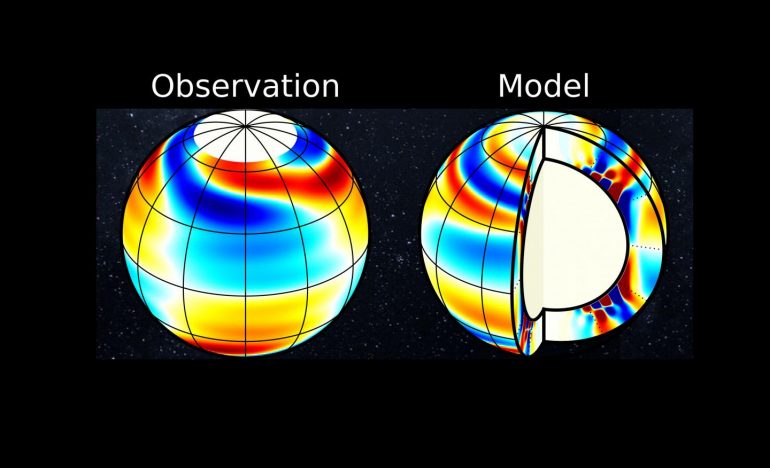They are traveling at speeds of up to five kilometers per hour: researchers report massive vortex movements on the Sun’s surface that can detect very long-period oscillations of the star. Using computer simulations, they were able to deduce that the newly discovered wave is apparently caused by the Sun’s so-called differential rotation. Scientists say these findings can now be used for further research into the internal structure and dynamics of our mother star.
Sinking ember streams: The surface and interior of the Sun are in constant motion. This dynamic characteristic can produce vibrations: it has been known since the 1960s that the Sun produces a “high sound”. Plasma currents near the Sun’s surface excite millions of so-called acoustic waves with short periods of about five minutes. The term mode describes the temporal characteristics of the waves.
These rapid oscillations of the Sun have been recorded by Earth-based telescopes and space observatories since the mid-1990s, because they can provide important information: they enable conclusions to be drawn about the Sun’s intrinsic characteristics—the same As seismologists conduct internal research of the Earth based on the effects of earthquakes, using what is known as helioseismology, researchers are already able to document rotation based on depth and heliographic latitude: hence the Sun. Matter moves at different speeds in different latitudes – this is known as differential rotation.
on the path of long-term oscillations
Already more than 40 years ago it was shown theoretically that stars should vibrate with significantly longer periods in addition to shorter ones. However, it has not yet been possible to clearly demonstrate these effects as they are comparatively elusive. As the international team led by Laurent Gijón from the Max Planck Institute for Solar System Research in Göttingen (MPS) explains, it was necessary to observe the horizontal movements of the Sun’s surface over several years to prove the long-term vibrations. Exactly such data was now available: Researchers were able to evaluate information from NASA’s Solar Dynamics Observatory (SDO) space probe, which includes observations of the Sun over a period of ten years.
Scientists are now able to detect a few dozen vibrations that correspond to the predicted long-period volumes. Some have their maximum flow velocity at the poles, others in mid-latitudes, and others near the Sun’s equator. “Long-period oscillations manifest as very slow vortex motion across the Sun’s surface at speeds of about five kilometers per hour. This is about as fast as a human goes,” said MPS co-author Zi-Chao Liang it is said.
To characterize the newly discovered vibrations more precisely, the scientists compared their observational data with results from computer models on the Sun’s dynamics. The simulations included information on the internal structure of the Sun, the characteristics of convective currents in the upper layers, and differential rotation derived from helioseismological research. “The model allowed us to look inside the Sun and reveal the full three-dimensional structure of the vibrations,” says MPS co-author Yuto Bekki.
Possibility of Solar Research Po
It became clear that the surface velocities in the model matched the observed vibrations well. The simulations also showed that the wave structures extend to a depth of 200,000 kilometers below the Sun’s surface. Above all, though, it became clear: “All of these new oscillations that we see on the Sun are strongly influenced by differential rotation,” says MPS co-author Damien Fournier. The dependence of the Sun’s rotation on latitude determines where the mode’s speed is greatest. “Vibrations also depend sensitively on the properties of the Sun’s interior. In particular, the strength of turbulent movements and the associated viscosity of the solar medium as well as the strength of the convection drive,” says his colleague Robert Cameron from MPS.
This clarifies: Research into long-period vibrations may also provide new insights into the Sun’s interior. Cameron says, “Just as we use acoustic vibrations with helioseismology to learn more about processes inside the Sun, we can use longer duration vibrations to learn more about turbulent processes. ” Gijón, first author, says: “The discovery of a new type of solar oscillation is very exciting. It allows us to infer properties such as the strength of the convection drive that ultimately controls the solar dynamo.”
Source: Max Planck Society, NASA, Expert Article: Astronomy and Astrophysics, doi: 10.1051/0004-6361/202141462

Internet fan. Alcohol expert. Beer ninja. Organizer. Certified tv specialist. Explorer. Social media nerd.





